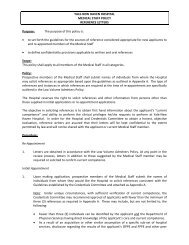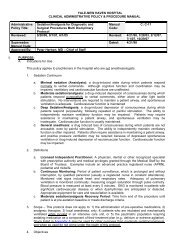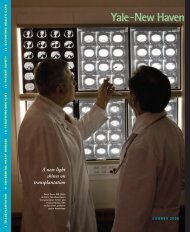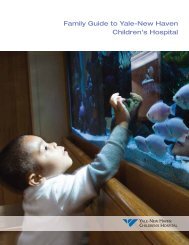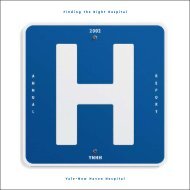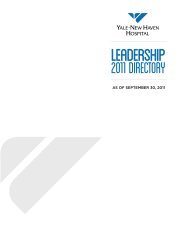Additional reading materials for conscious sedation - Yale-New ...
Additional reading materials for conscious sedation - Yale-New ...
Additional reading materials for conscious sedation - Yale-New ...
Create successful ePaper yourself
Turn your PDF publications into a flip-book with our unique Google optimized e-Paper software.
YALE-NEW HAVEN HOSPITAL<br />
PRIVILEGES TO PERFORM CONSCIOUS (Moderate) SEDATION<br />
Because of the nature of their practice, many physicians require the privilege of ordering and supervising<br />
<strong>conscious</strong> <strong>sedation</strong>. Physicians who do not regularly use this technique within the <strong>Yale</strong>-<strong>New</strong> Haven<br />
Hospital inpatient or ambulatory care areas should have no use <strong>for</strong> this privilege. (Note: allowing your<br />
privilege to expire at re-appointment will not prompt any reporting to external physician monitoring<br />
databases).<br />
Conscious Sedation, now called moderate <strong>sedation</strong> by the Joint Commission, is a specific technique used<br />
to facilitate invasive procedures on non-intubated patients. In adults, <strong>conscious</strong> <strong>sedation</strong> is primarily<br />
used <strong>for</strong> significant interventional procedures in Diagnostic Imaging or special treatment areas.*<br />
Orthopedic surgeons may use moderate <strong>sedation</strong> <strong>for</strong> closed fracture reductions and other bedside<br />
procedures. Most other surgeons and obstetricians use this technique in their offices, but not in the<br />
Hospital's OR's or delivery rooms. This technique is widely used in Pediatrics <strong>for</strong> many procedures and<br />
tests requiring patient cooperation. The following definitions help differentiate minimal <strong>sedation</strong> from<br />
moderate <strong>sedation</strong>:<br />
* Interventional sub-specialists such as cardiologists, pulmonologists, and gastroenterologists<br />
routinely use moderate <strong>sedation</strong> in their laboratories.<br />
• Minimal <strong>sedation</strong> (Anxiolysis): a drug-induced state during which patients respond normally to<br />
verbal commands. Although cognitive function and coordination may be impaired, ventilatory and<br />
cardiovascular functions are unaffected. Note: no special privilege is needed <strong>for</strong> this level of<br />
<strong>sedation</strong>. However, the primary goal of this level of <strong>sedation</strong> is to reduce anxiety, not to reduce<br />
patient movement or modify pain response.<br />
• Moderate <strong>sedation</strong>/analgesia: a drug -induced depression of <strong>conscious</strong>ness, during which patients<br />
respond purposefully to verbal commands, either alone or after light tactile stimulation. No<br />
interventions are required to maintain a patent airway, and spontaneous ventilation is adequate.<br />
Cardiovascular function is usually maintained.<br />
If you wish to obtain privileges <strong>for</strong> <strong>conscious</strong> <strong>sedation</strong> at <strong>Yale</strong>-<strong>New</strong> Haven Hospital, the<br />
requirements are as follows:<br />
1. Provide proof of certification in Basic Life Support (BLS) or more advanced training (i.e. ACLS,<br />
PALS, ATLS, NRP) within the past four years.<br />
Or<br />
Complete a 30 minute Y-NHHospital-sponsored airway management practicum. (Contact the<br />
Department of Emergency Medicine at 785-4710 to register)<br />
2. Read the <strong>materials</strong> that follow this document, sign the “Attestation” and complete the “Self-Test”.<br />
3. Return the signed “Attestation”, completed “Self-Test” and your documentation of airway<br />
management training (#1 above) to the Department of Physician Services, Hunter 4.<br />
Conscious <strong>sedation</strong> privileges will be issued upon the Department of Physician Services receipt of<br />
proof of your current certification or completion of the practicum (as indicated in #1) and “Self-<br />
Test” with a passing score.<br />
Please Note: Dentists who wish to administer <strong>conscious</strong> <strong>sedation</strong> at YNHH must have a current<br />
State of CT Dental Conscious Sedation Permit.<br />
If you have questions, after reviewing your practice and these considerations, concerning whether you<br />
should obtain privileges <strong>for</strong> <strong>conscious</strong> <strong>sedation</strong>, please contact the Department of Physician Services at<br />
(203) 688-2615.
YALE-NEW HAVEN HOSPITAL<br />
Conscious (Moderate) Sedation<br />
SEDATION/ANALGESIA<br />
EDUCATIONAL MODULE<br />
This document covers important in<strong>for</strong>mation from the <strong>Yale</strong>-<strong>New</strong> Haven Hospital<br />
Multidisciplinary Protocol For Management Of Patients Receiving Sedation/Analgesia For<br />
Diagnostic, Surgical And Interventional Procedures.<br />
In order to apply <strong>for</strong> privileges in Conscious (Moderate) Sedation, you must:<br />
1. Read the attached material<br />
2. Sign the Attestation <strong>for</strong>m that follows indicating that you have read and understand the<br />
contents of the Educational Module<br />
3. Complete the “Sedation / Analgesia Self-Test”<br />
4. Provide a copy of your certificate in BLS, ACLS, PALS, ATLS, NRP indicating<br />
certification within the past four years OR contact the Department of Emergency<br />
Medicine at 785-4710 to register <strong>for</strong> the 30 minute Y-NHHospital-sponsored airway<br />
management practicum.<br />
Return your completed test and certificate copy to:<br />
<strong>Yale</strong>-<strong>New</strong> Haven Hospital<br />
Department of Physician Services<br />
20 York Street, Hunter 4<br />
<strong>New</strong> Haven, CT 06504
Moderate Sedation Medications<br />
The guidelines <strong>for</strong> administration of moderate <strong>sedation</strong> medications are reviewed in section VI of the<br />
attached YNHH Moderate Sedation/Analgesia Protocol. 2 These guidelines recommend:<br />
A. Administer moderate <strong>sedation</strong> medications, as outlined in Appendix A, slowly and in small<br />
incremental doses<br />
B. Assess the therapeutic effect be<strong>for</strong>e determining the next incremental dose and observe the patient<br />
<strong>for</strong>:<br />
1. Decreased 02 saturation<br />
2. Ability to maintain airway<br />
3. Appropriate response to physical stimulation and/or verbal commend<br />
4. Significant changes in vital signs<br />
C. Adjust dosages based upon patient’s age, level of debilitation, drug combinations, patient tolerance,<br />
pulmonary reserve, previous narcotic usage and length of procedure.<br />
***The potential <strong>for</strong> respiratory depression increases when drugs are combined.***<br />
Benzodiazapines<br />
The most common IV <strong>sedation</strong> medications used in both adults and children are the benzodiazepines,<br />
midazolam (Versed) and diazapam (Valium). Benzodiazapines have several pharmacologic actions that<br />
make them worthy choices <strong>for</strong> moderate <strong>sedation</strong>. These actions include anxiolysis, amnesia, muscle<br />
relaxation, <strong>sedation</strong> and anti-convulsant. Benzodiazepines do not have analgesic effects. Midazolam is<br />
two to three times as potent as diazepam. Lorazepam (Ativan) is five to ten times more potent than<br />
diazapam and has profound anterograde amnestic affects. It is recommended that these drugs be<br />
administered slowly, over 2-3 minutes in the case of an adult and over at least 3 minutes in pediatric<br />
cases. Slow infusion is recommended to avoid respiratory depression or apnea. Sedation usually occurs<br />
within 3-5 minutes of IV administration.<br />
Opioids<br />
During moderate <strong>sedation</strong>, narcotics can be prescribed to provide pain control/analgesia. These<br />
mediations may either be natural or synthetic compounds. Narcotics commonly used in moderate<br />
<strong>sedation</strong> include fentanyl, morphine sulfate, and meperidine (Demerol). Meperidine is becoming less<br />
frequently used. It is contraindicated if patients are on MAO inhibitors, and because of variable renal<br />
excretion can cause seizures and delerium in situations other than very short term use.<br />
Oral Sedatives<br />
Oral medications may also be used to provide moderate <strong>sedation</strong>. Oral sedatives may provide a less<br />
invasive means of medicating patients, and are used commonly in young children. Three of the most<br />
common oral sedatives include: midazolam, diazapam and chloral hydrate. As with all medications<br />
administered to provide moderate <strong>sedation</strong>, oral preparations require vigilant patient monitoring and<br />
assessment. Monitoring is required in order to maintain patient com<strong>for</strong>t and safety throughout the<br />
<strong>sedation</strong>. Several variables affecting the efficacy of oral preparations include: dosage, rate of absorption<br />
and case specific risk factors (i.e. age, patient history, disease process, level of anxiety). Inadequate<br />
<strong>sedation</strong> or over <strong>sedation</strong> may be related to these variables.<br />
Reversal Agents<br />
Antagonists are administered to reverse the effects of medication used <strong>for</strong> moderate <strong>sedation</strong>. Naloxone<br />
reverses opiod effects and flumazenil reverses benzodiazepine effects. The half-life of reversal agents is<br />
generally shorter than that of the medications they reverse. If reversal agents are administered, it is vital
to provide careful patient assessment <strong>for</strong> signs of re-<strong>sedation</strong>. Patients may be at risk <strong>for</strong> re-<strong>sedation</strong> <strong>for</strong><br />
up to two hours.<br />
Nitrous Oxide<br />
<strong>Yale</strong> <strong>New</strong> Haven Hospital Sedation/Analgesia Protocol includes the administration of Nitrous Oxide.<br />
The Sedation/Analgesia Protocol must be followed when the concentration of N 2 O is greater than 50% or<br />
it is administered in combination with other <strong>sedation</strong>/analgesia medications as described in Appendix A<br />
or B of the Sedation/Analgesia Protocol. 2<br />
**Specific dosing/drug in<strong>for</strong>mation is provided in the Sedation/Analgesia Protocol **<br />
Appendix A. 2<br />
Pre-Sedation Considerations:<br />
The intent of moderate <strong>sedation</strong> is to provide <strong>sedation</strong> and analgesia during diagnostic, interventional, or<br />
surgical procedures. Appropriate patient selection and careful assessment of moderate <strong>sedation</strong> risk is<br />
necessary to provide optimal patient outcomes. 1,2<br />
In 2002, the American Society of Anesthesiologists (ASA) published guidelines <strong>for</strong> <strong>sedation</strong> and<br />
analgesia by non-anesthesiologists. This document details risk factors <strong>for</strong> moderate <strong>sedation</strong>:<br />
uncooperative patients, extremes of age, severe obesity, pregnancy, sleep apnea, drug or ETOH abuse,<br />
facial or airway abnormalities that would make intubation or mask ventilation difficult, and severe<br />
cardiac, pulmonary, hepatic, renal or neurologic (e.g., altered gag reflex) disease. The ASA recommends<br />
that an anesthesiologist be consulted <strong>for</strong> patients with these risk factors and underlying conditions.<br />
In<strong>for</strong>mation sought and documented as part of the pre-<strong>sedation</strong> clinical assessment also helps to identify<br />
patients at risk <strong>for</strong> complications. Important individual factors include: pertinent medical/surgical history,<br />
drug allergies, current medications, airway and cardiopulmonary exam, and time/type of last PO intake. 3<br />
Prior to <strong>sedation</strong>, an ASA Score must also be determined. The ASA employs a numeric patient<br />
classification system (ASA Score) to estimate anesthesia risk status. The complete scoring system is<br />
detailed in Appendix C in the attached YNHH MULTI DISCIPLINARY PROTOCOL FOR<br />
MANAGEMENT OF PATIENTS RECEIVING SEDATION/ ANALGESIA FOR DIAGNOSTIC,<br />
SURGICAL AND INTERVENTIONAL PROCEDURES.<br />
The following patient care/in<strong>for</strong>mation must be obtained and documented be<strong>for</strong>e the patient is<br />
sedated:<br />
• A physical examination per<strong>for</strong>med by a physician, dentist, or other credentialled licensed independent<br />
practitioner (LIP, e.g., nurse practitioner, physician's assistant) documented within 30 days of the<br />
proposed procedure.<br />
• Medication orders written/entered by a physician, dentist, or LIP, who will be immediately available<br />
during the procedure.<br />
• In<strong>for</strong>med Consent <strong>for</strong> the proposed procedure and <strong>sedation</strong> must be documented in the patient chart.<br />
• Patients are instructed be<strong>for</strong>e the procedure to avoid: making any major decisions, operating heavy<br />
equipment or drinking alcohol <strong>for</strong> 24 hours after the procedure. 5.2<br />
• Ambulatory patients must verify a responsible adult will accompany them at discharge. If unable to<br />
verify this in<strong>for</strong>mation, the procedure must be canceled and rescheduled.<br />
The day of the procedure:<br />
• The physician, dentist or LIP will document an ASA Score, and evaluate the patient <strong>for</strong> individual<br />
factors indicating increased risk of <strong>sedation</strong>.<br />
• Physical assessment per<strong>for</strong>med immediately be<strong>for</strong>e the procedure documents the patient’s baseline<br />
airway and cardiopulmonary status.
• Determine and document baseline temperature, heart rate and rhythm, respiratory rate, blood<br />
pressure, oxygen saturation, level of <strong>conscious</strong>ness, Modified Aldretti Score (Appendix H), and<br />
intravenous access (appendix A).<br />
• Emergency equipment must be available and checked <strong>for</strong> function (appendix E).<br />
Intra-procedural Considerations:<br />
During <strong>sedation</strong> the physician, dentist, or LIP must be in the immediate procedural area. In order to<br />
monitor the efficacy of <strong>sedation</strong> and ensure patient safety, continuous monitoring of the patient's<br />
physiologic parameters is required during moderate <strong>sedation</strong>. These parameters include: level of<br />
<strong>conscious</strong>ness, adequacy of <strong>sedation</strong>, heart rate, respiratory rate and pattern, and oxygen saturation. Blood<br />
pressure should be measured every 5 minutes. Documentation of pulse, BP, R, O 2 Sat, LOC, and pain<br />
must occur every 15 minutes during the procedure. At the conclusion of the procedure, heart rate, oxygen<br />
saturation, and blood pressure must be repeated and documented.<br />
Careful documentation of medications used <strong>for</strong> <strong>sedation</strong> is important. The time, type and dose of<br />
medication used, as well as route of administration should be noted in the clinical record.<br />
Every medical procedure carries risks. Practitioners caring <strong>for</strong> patients receiving moderate <strong>sedation</strong> must<br />
be attentive to the possibility of <strong>sedation</strong> related complications. Complications may include: aspiration,<br />
hypoventilation, loss of independent airway, hyper- or hypotension, or cardiac arrhythmia/arrest. 2.5 Any<br />
complications occurring during moderate <strong>sedation</strong> or the recovery period must be reported on the YNHH<br />
Sedation Analgesia Adverse Event Form.<br />
Post-procedural Considerations:<br />
Patients maintain their need <strong>for</strong> continuous monitoring during the recovery period. The RN, physician,<br />
dentist or LIP must be in the immediate recovery area while the patient is recuperating. Heart rate and<br />
rhythm, respiratory rate and pattern, blood pressure, oxygen saturation, level of <strong>conscious</strong>ness and<br />
adequacy of <strong>sedation</strong> is to be documented on admission to the recovery area, or beginning of the recovery<br />
period. Patient assessment includes evaluation every 15 minutes <strong>for</strong> one-hour (minimum) after the last<br />
administration of <strong>sedation</strong> medication. Vital signs and oxygen saturation should be monitored as<br />
appropriate <strong>for</strong> the patients’ age and condition. Patients who have received reversal agents should be<br />
carefully monitored <strong>for</strong> re<strong>sedation</strong>.<br />
The <strong>Yale</strong> <strong>New</strong> Haven Hospital Nursing Organization and Practice Manual standard of care <strong>for</strong><br />
moderate <strong>sedation</strong> instructs nurses to document and report the following post-procedure conditions to the<br />
physician, dentist or LIP: respiratory depression/distress, oxygen saturation < 90% <strong>for</strong> adults (< 95% <strong>for</strong><br />
children), vital signs outside the normal limits <strong>for</strong> age and condition, diaphoresis, vaso-vagal reaction or<br />
emesis.<br />
Clinical Discharge Criteria<br />
Clinical criteria outlined in the <strong>Yale</strong> <strong>New</strong> Haven Hospital Sedation/Analgesia Protocol determine<br />
when a patient may be discharged from the moderate <strong>sedation</strong> protocol. The Modified Aldretti Score<br />
(MAS) is used. The MAS must be assessed prior to initiating <strong>sedation</strong>, and the patient can be discharged<br />
from the protocol when their score is > 7 on the 8 point Score. If a patient's baseline Score is 6, then the<br />
patient may be discharged on reaching this baseline, as long as an explanatory note is documented in the<br />
record. After appropriate assessment, a physician, dentist, or LIP may discharge the patient from the<br />
moderate <strong>sedation</strong> protocol 'off-criteria' at their clinical discretion, but must sign the <strong>sedation</strong> record at the<br />
time of discharge.<br />
Documentation of heart rate and rhythm, blood pressure, respiratory rate and pattern is required<br />
immediately be<strong>for</strong>e discharge from the recovery area and protocol. Prior to <strong>sedation</strong>, the patient should<br />
have been provided with verbal and written instructions regarding effects of moderate <strong>sedation</strong>, activity
limitations, recommended diet, and medication regimen 5.2 . Prior to discharge this in<strong>for</strong>mation should be<br />
reviewed and understanding signed. In addition, the name/number of an emergency contact should be<br />
provided to the patient and accompanying adult.<br />
Transportation of sedated patients<br />
All patients should meet discharge criteria as described above be<strong>for</strong>e transportation to an inpatient bed. If<br />
transportation must occur be<strong>for</strong>e the patient is fully recovered from <strong>sedation</strong>, a physician, dentist,<br />
physician’s assistant or RN must accompany the patient to maintain patient safety and comply with<br />
hospital protocol. Heart rate and oxygen saturation will be continuously monitored while in transit. The<br />
physician, dentist, LIP, or RN will remain with and continue monitoring the patient until one of the<br />
following occurs:<br />
1. The patient is at pre-<strong>sedation</strong> baseline<br />
2. The patient meets clinical discharge criteria<br />
3. The unit receiving the transported patient (i.e. intensive care unit or out patient recovery unit)<br />
provides staff to assume responsibility <strong>for</strong> the continuous monitoring of the patient through<br />
the recovery period. 2.5<br />
Physician, Dentist and LIP Responsibilities: 2.5<br />
* It is the responsibility of the attending physician, dentist or LIP to maintain delineated privileges to<br />
administer <strong>sedation</strong> <strong>for</strong> diagnostic/interventional/surgical procedures. Criteria <strong>for</strong> clinical privileges<br />
may be found in the YNHH Sedation/Analgesia Protocol<br />
* The attending physician, dentist or LIP must evaluate, prior to and the day of the procedure, factors<br />
that would increase patient risk <strong>for</strong> moderate <strong>sedation</strong>.<br />
* The attending physician, dentist or LIP must remain immediately available during the procedure.<br />
* Assure that heart rate, respiratory rate and pattern, oxygen saturation, level of <strong>conscious</strong>ness and<br />
adequacy of <strong>sedation</strong> are monitored and communicated continuously.<br />
* The physician, dentist, LIP or RN must be in the immediate recovery area during the patient’s<br />
recovery.<br />
* A clinical record of moderate <strong>sedation</strong> must be maintained and be made part of the patient’s medical<br />
record.<br />
* The attending physician, dentist or LIP must document the following in<strong>for</strong>mation:<br />
MD, dentist, LIP<br />
Responsibilities<br />
Requiring<br />
Clinical Record<br />
Documentation<br />
* Medication orders must be written/entered by a physician, dentist,<br />
or LIP. Any intra-procedure verbal orders must be signed<br />
immediately after procedure completion<br />
* History and physical (H&P) must be per<strong>for</strong>med and documented by<br />
a physician, dentist or LIP within 30 days of the procedure.<br />
* Last PO intake must be determined by the physician, dentist or LIP<br />
and documented the day of the procedure.<br />
* In<strong>for</strong>med consent must be obtained <strong>for</strong> proposed procedure<br />
including consent <strong>for</strong> <strong>sedation</strong> through a discussion of anesthesia<br />
options, benefits, and risks.<br />
Registered Nurse (RN) Responsibilities: 2.5<br />
* Moderate <strong>sedation</strong> medications must be written/entered by a physician, dentist, or LIP who will be<br />
immediately available during the procedure.<br />
* If <strong>sedation</strong> is to be provided through intravenous access, the Guidelines <strong>for</strong> IV administration must be<br />
followed.<br />
* The RN will provide size/age appropriate equipment including: pulse oximeter, blood pressure<br />
apparatus, EKG monitor, defibrillator, manual resuscitator (Jackson Reese, Ambu bag) and mask,<br />
suction, airway, emergency cart (codes 5 and/or 7) and supplemental oxygen.
* Medication reversal agents (i.e. flumazenil/naloxone) are immediately available.<br />
* Pre-<strong>sedation</strong> the RN will verify patient connection to a responsible adult <strong>for</strong> future discharge.<br />
* Pre-<strong>sedation</strong> the RN will instruct the patient to avoid: drinking alcohol, operating heavy equipment,<br />
or make any major decisions <strong>for</strong> 24 hours after discharge and obtain a signature acknowledging these<br />
instructions.<br />
* The physician, dentist, LIP and/or RN will monitor HR, RR and Pattern, O 2 sat, LOC and pain<br />
continuously.<br />
RN Responsibilities<br />
Requiring<br />
Clinical Record<br />
Documentation<br />
Baseline: The RN will obtain and document baseline temperature,<br />
heart rate and rhythm, respiratory rate, blood pressure, oxygen<br />
saturation, level of <strong>conscious</strong>ness, Modified Aldretti Score (MAS),<br />
intravenous access and assess completion of the multidisciplinary<br />
flow sheet.<br />
During the procedure: The RN will assess and document heart rate<br />
and oxygen saturation every 15 minutes during, and at the conclusion<br />
of the procedure. Blood pressure will be assessed and documented<br />
every 30 minutes and at the conclusion of the procedure.<br />
Recovery: The physician, dentist, LIP, or RN will document heart<br />
rate and rhythm respiratory rate and pattern, oxygen saturation,<br />
level of <strong>conscious</strong>ness, MAS, and adequacy of <strong>sedation</strong> at completion<br />
of procedure (if per<strong>for</strong>med at bedside), and/or on admission to and<br />
throughout recovery. Immediately prior to discharge from the<br />
recovery area/period, documentation of heart rate and rhythm,<br />
respiratory rate and blood pressure is required. The patient's<br />
(parent's or guardian's <strong>for</strong> pediatric patients) signature is required on<br />
in<strong>for</strong>mation regarding discharge instructions.<br />
References<br />
1. Joint Commission on the Accreditation of Healthcare Organizations, Comprehensive Accreditation<br />
Manuals <strong>for</strong> Hospitals, 2002.<br />
2. <strong>Yale</strong> <strong>New</strong> Haven Hospital Policy and Procedure Manual: Multi-Disciplinary Protocol <strong>for</strong><br />
Management of Patients Receiving Sedation/Analgesia <strong>for</strong> Diagnostic, Surgical and Interventional<br />
Procedures. <strong>New</strong> Haven, CT: n.p. July 1996, revised April 1998, December 2000, June 2002.<br />
3. American Society of Anesthesiologist Inc.; Practice Guidelines <strong>for</strong> Sedation and Analgesia by Non-<br />
Anesthesiologists. Anesthesiology 2002; 96:1004-1017.<br />
4. American Nurses Association. Endorsement of Position Statement on the Role of the Registered<br />
Nurse (RN) in the Management of Patients Receiving IV <strong>for</strong> Short – Term Therapeutic, Diagnostic,<br />
or Surgical Procedures. N.p: n.p. September 1991.<br />
5. <strong>Yale</strong> <strong>New</strong> Haven Hospital Nursing Organization and Practice Manual Vol.II, Standard of Care<br />
Statement: <strong>New</strong> Haven, CT: n.p. June 2002.<br />
6. Pharmacology and Physiology in Anesthetic Practice, Stoelting RK. Philadelphia, PA: Lippincott,<br />
1987.<br />
7. American Society of Anesthesiologists. Manual <strong>for</strong> Anesthesia Department Organization and<br />
Management, 1999 Park Ridge Illinois, pg. 141.
Bibliography <strong>for</strong> Specialty Consideration<br />
Goldner BG., Baker J. et al: Electrical cardioversion of atrial fibrillation or flutter with in the age of cost<br />
containment. American Heart Journal. Dec 1998; 136(6):961-4<br />
Parworth LP., Frost DE. Et al; Propofol and fentanyl compared with midazolam and fentanyl during third<br />
molar surgery. J Oral Maxillofac Surg. 1998; 46(4):447-53<br />
Litman RS.Kottra JA. Et al; Chloral hydrate <strong>sedation</strong>: the additive sedative and respiratory depressant<br />
effects of nitrous oxide. Anesthesia & Analgesia. Apr.1998;86(4):724-8<br />
Jagoda A, Campbell M. et al; Clinical policy <strong>for</strong> procedural <strong>sedation</strong> and analgesia in the emergency<br />
department. Ann Emerg Med. May 1998; 31:5 663-677.<br />
Lazzaroni M. Bianchi-Porro G.; Premedication, preparation and surveillance. Endoscopy. Jan 1999;<br />
31(1):2-8.<br />
Eige S., Pritts EA. Et al; Anesthesia <strong>for</strong> office endoscopy. Obstetrics & Gynecology Clinics of North<br />
America. Mar. 1999; 26(1):99-108.<br />
Trout SW, Vallerand AH, Kemmann E; Conscious <strong>sedation</strong> <strong>for</strong> in vitro fertilization. Fertil Steril. May<br />
1998: 69:799-808.<br />
Litman RS. Sedation and anesthesia outside the operating room: answers to common questions. Seminar<br />
in Pediatric Surgery. May 1999; 8(1): 34-9.<br />
Lipshitz, M., et al., Chloral Hydrate Side Effects in Young Children: Cause and Management Heart and<br />
Lung, Sept/Oct. 408. 1993.<br />
Steinberg, A. Should Chloral Hydrate be Banned? Pediatrics, 92(3), 442, 1993.<br />
Tolksdorf, W. et al., Premedication in School Aged Children with Oral, Rectal and Nasal Midazolam.<br />
Anesthesia and Analgesia, 72, 297. 1991.<br />
Byun MY. Fine NA. Et al; The clinical outcome of abdominoplasty per<strong>for</strong>med under: increased use of<br />
fentanyl correlated with longer stay in outpatient unit. Plastic & Reconstructive Surgery. Apr. 1999;<br />
103(4):1260-6<br />
Kobs A. Questions About the Anesthesia Continuum. Nursing Management 1997: 28(4): 14,17.<br />
Joseph MH. Brill J. Zeltzer LK.; Pediatric pain relief in trauma. Pediatrics in Review. Mar. 1999;<br />
20(3):75-84.


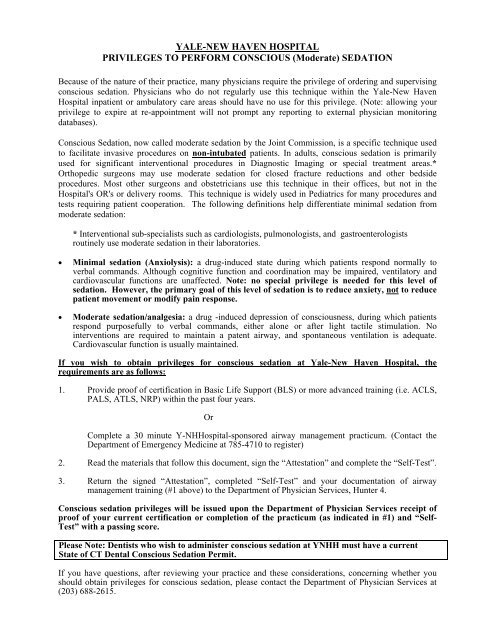
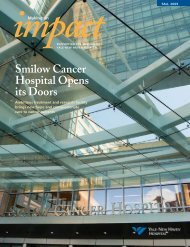


![Annual Report Donor Listings [pdf] - Yale-New Haven Hospital](https://img.yumpu.com/49673575/1/190x245/annual-report-donor-listings-pdf-yale-new-haven-hospital.jpg?quality=85)

